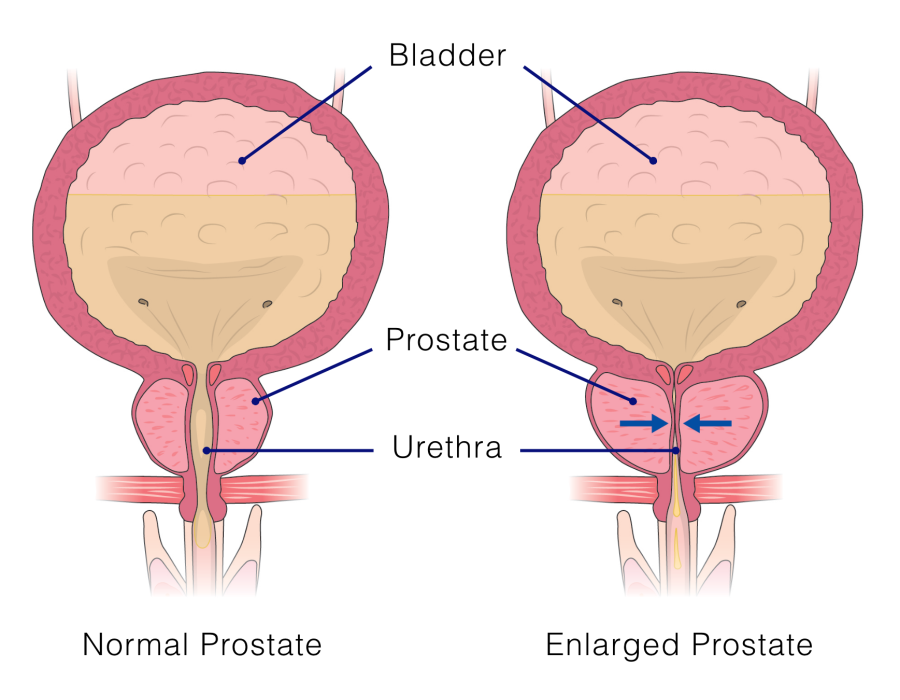BPH stands for Benign Prostatic Hyperplasia, a common condition.
Your prostate naturally enlarges as you get older—and that’s very common1. The prostate gland is a part of the male reproductive system that produces most of the seminal fluid. Normally, a prostate weighs about 20 grams and is the size of a walnut. The prostate is located below the bladder and surrounds part of the urethra, a thin tube that transports urine from the body.2
In some men, as the prostate enlarges, it also puts pressure on the urethra and causes it to narrow, making it difficult to urinate.2
1. Urology Health Foundation. (September 2021). Benign Prostatic Hyperplasia (BPH). Available at: https://www.urologyhealth.org/urology-a-z/b/benign-prostatic-hyperplasia-(bph)#Prescription_Drugs
2. Sandhu JS, Bixler BR, Dahm P, et al. Management of lower urinary tract symptoms attributed to benign prostatic hyperplasia (BPH): AUA Guideline amendment 2023. J Urol. 2023;10.1097/JU.0000000000003698. https://doi.org/10.1097/JU.0000000000003698

Image property of Olympus.
BPH Symptoms2
Waking up several times
a night to urinate
Weak, interrupted
urine stream
Hard time starting
and stopping and/or an
inability to go when you
feel the need
Feeling a sudden
urge to urinate
Not sure your
bladder is empty
2. Sandhu JS, Bixler BR, Dahm P, et al. Management of lower urinary tract symptoms attributed to benign prostatic hyperplasia (BPH): AUA Guideline amendment 2023. J Urol. 2023;10.1097/JU.0000000000003698. https://doi.org/10.1097/JU.0000000000003698
Have you experienced any of these common BPH symptoms?
The International Prostate Symptom Score (IPSS) questionnaire was developed to measure the severity of your BPH symptoms.3
Your score is not meant to provide medical advice or replace your doctor’s expert opinion and care. Only your doctor can diagnose whether you have BPH and assess your individual condition.
3. The International Prostate Symptom Score (IPSS) questionnaire was developed by the American Urological Association (AUA) and Olympus does not own this questionnaire.

The iTind™ procedure is a minimally invasive therapy for bothersome lower urinary tract symptoms in men with BPH
Surgical & Other Options
Watchful Waiting
If your symptoms are mild and do not affect your quality of life to a great degree, your doctor may recommend a conservative “wait and watch” approach. Together you and your doctor will monitor your condition by tracking your symptoms and will discuss the risks of watchful waiting.
Prescription and Non-Prescription
There are a number of prescription medications to manage BPH symptoms. These include alpha blockers, which relax the muscles around the neck of the bladder making it easier to urinate, and alpha reductase inhibitors which are used to shrink the prostate. These medications have been widely studied and help many patients feel relief from their urinary symptoms. Some patients experience side effects on BPH medications, including dizziness, headaches, and sexual dysfunction.2
Prostate Reshaping (iTind Procedure)
The iTind procedure is an alternative to prescription medications and invasive surgical treatment that relieves lower urinary tract symptoms due to an enlarged prostate. The iTind procedure reshapes the prostate to allow for better urine flow and provides rapid symptomatic relief to patients.4,5
Unlike other non-surgical BPH procedures, the procedure involves no heating or removal of prostate tissue, and no permanent implant is left behind.
Some patients experience side effects during the procedure, but they are generally only mild to moderate. Side effects, if experienced, include pain or burning with urination, blood in the urine, pelvic pain, an urgent need to urinate and/or the inability to control the urge. Most of these side effects occur during the 5 to 7 day treatment period and resolve shortly after the device is removed.
Prostatic Urethral Lift (PUL)
This procedure utilizes permanent implants to lift and hold the enlarged prostate tissue out of the way so urine can flow through the prostatic urethra. The procedure provides rapid symptomatic relief with durable results and many patients go home without a catheter. However, patients should consider risks associated with a permanent implant.6
The most common side effects are mild to moderate and include pain or burning with urination, blood in the urine, pelvic pain, urgent need to urinate and/or the inability to control the urge.
Steam Therapy
Steam therapies use the natural energy stored in water vapor, to shrink enlarged prostates. Most patients begin to experience symptom relief within two weeks, and maximum benefit may be reached within three months.7,8 However, applying heat to the prostate can cause the tissue to swell and therefore often require a few days or weeks of post-operative catheterization. For some patients, this may result in a longer time returning to normal life.7,8
Plasma Vaporization Therapy
An effective treatment for BPH is Plasma Vaporization Therapy. The PlasmaButton™ device gently vaporizes the enlarged prostate tissue. Plasma Vaporization Therapy has shown a reduction in procedure time and catheterization time post-operatively while delivering long-lasting results and a quick return to normal activity.9 Learn more about Plasma Therapy.
Use of incompatible/non-validated equipment with the ESG-410 electrosurgical generator can lead to excessive/incorrect HF output. This can result in thermal injuries or death to the patient, and the operator as well as damage to the system. Improper use will void the warranty of the Olympus generator, endoscopes, and accessories.
Transurethral Resection of the Prostate (TURP)
TURP is a surgical procedure where the prostate is cut out to gain space for normal urination and other BPH symptom relief. During the procedure, the prostate is reached by inserting a thin, tube-like instrument called a resectoscope through the urethra. A camera on the end of the resectoscope provides a magnified view of the prostate, and a loop at the tip of the resectoscope is passed along the prostate, removing the enlarged and obstructing tissue. TURP procedures are safe and have long-lasting results in treating BPH symptoms. TURP has traditionally been the “gold standard” in treatment for men with BPH.2 After a TURP procedure, there is a risk of bleeding and short- and long-term complications.
Laser Therapies
Laser resection of the prostate is a less-invasive surgical procedure known as either photoselective vaporization of the prostate (PVP) or holmium laser enucleation (HoLEP). The risks and complications are similar to those seen with TURP and typically a catheter is required after the procedure.2
Enucleation
Enucleation can be performed through two different surgical methods: Plasma Enucleation is performed using the most common resection equipment and completely frees the benign tissue from the gland to provide relief of enlarged prostate symptoms. Laser Enucleation is a procedure which uses a laser to remove tissue that is blocking urine flow through the prostate.
Enucleation may cause hematuria, irritation of the bladder that results in frequent and/or urgent urination, irritation of the urethra that results in frequent urination and/or a burning sensation, or retrograde ejaculation.
1. Urology Health Foundation. (September 2021). Benign Prostatic Hyperplasia (BPH). Available at: https://www.urologyhealth.org/urology-a-z/b/benign-prostatic-hyperplasia-(bph)#Prescription_Drugs
2. Sandhu JS, Bixler BR, Dahm P, et al. Management of lower urinary tract symptoms attributed to benign prostatic hyperplasia (BPH): AUA Guideline amendment 2023. J Urol. 2023;10.1097/JU.0000000000003698. https://doi.org/10.1097/JU.0000000000003698
3. The International Prostate Symptom Score (IPSS) questionnaire was developed by the American Urological Association (AUA) and Olympus does not own this questionnaire.
4. Chughtai B, Elterman D, Shore N, et al. The iTind Temporarily Implanted Nitinol Device for the Treatment of Lower Urinary Tract Symptoms Secondary to Benign Prostatic Hyperplasia: A Multicenter, Randomized, Controlled Trial. Urology. 2020.
5. Amparore D, Fiori C, Valerio M, et al. 3-Year results following treatment with the second generation of the temporary implantable nitinol device in men with LUTS secondary to benign prostatic obstruction. Prostate Cancer Prostatic Dis. 2021.
6. Roehrborn CG, Barkin J, Gange SN, Shore ND, Giddens JL, Bolton DM, Cowan BE, Cantwell AL, McVary KT, Te AE, Gholami SS, Moseley WG, Chin PT, Dowling WT, Freedman SJ, Incze PF, Coffield KS, Herron S, Rashid P, Rukstalis DB. Five year results of the prospective randomized controlled prostatic urethral L.I.F.T. study. Can J Urol. 2017 Jun;24(3):8802-8813. PMID: 28646935.
7. McVary KT, Rogers T, Roehrborn CG. Rezūm water vapor thermal therapy for lower urinary tract symptoms associated with benign prostatic hyperplasia: 4-year results from randomized controlled study. Urology. 2019 Apr;126:171-9.
8. McVary KT, Gange SN, Gittelman MC, et al. Minimally invasive prostate convective water vapor energy ablation: A multicenter, randomized, controlled study for the treatment of lower urinary tract symptoms secondary to benign prostatic hyperplasia. J Urol. 2016 May;195(5):1529-38.
9. Pham BS, Parke MD, and Kernen MD, How I do it: Same day discharge for transurethral resection of prostate using Olympus PlasmaButton™ and PlasmaLoop™. Available at: http://www.canjurol.com/html/free-articles/JUV23_I5_16_FREE_DrKernenSECURE.pdf






